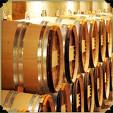You can do a few bad things before you get a reputation for being a bad person. (I’m rather grateful for that, as one whose youth was a bit, um, mis-spent.) But once you get a bad reputation, it is very hard to shake–almost no matter how many good things you do.
This latter situation is the lamentable circumstance now  confronting Chardonnay. So much bad Chardonnay was made in the two decades between 1985 and 2005 that it is now saddled with a rotten reputation among relatively sophisticated consumers. And though the style and quality situation for Chardonnay has changed dramatically during the past three years, any upswing in the variety’s reputation has been much less dramatic.
confronting Chardonnay. So much bad Chardonnay was made in the two decades between 1985 and 2005 that it is now saddled with a rotten reputation among relatively sophisticated consumers. And though the style and quality situation for Chardonnay has changed dramatically during the past three years, any upswing in the variety’s reputation has been much less dramatic.
These observations were stirred in part by reading Mary Ewing- Mulligan’s remarks on Bouchaine’s 2006 Chardonnay in her new “On My Table” feature. Mary has written about five Chardonnays during the past two months, which is saying something since her feature runs on WRO bi-weekly. She implies that there’s a discrepancy between Chardonnay’s reputation and the wines she’s now encountering.
Mulligan’s remarks on Bouchaine’s 2006 Chardonnay in her new “On My Table” feature. Mary has written about five Chardonnays during the past two months, which is saying something since her feature runs on WRO bi-weekly. She implies that there’s a discrepancy between Chardonnay’s reputation and the wines she’s now encountering.
That’s true for me as well. After years of being afraid to face a bottle of Chardonnay without a preliminary shot of Novocain, I’m now finding that the excesses that have plagued the wines are now rare rather than ubiquitous. Moreover, this is increasingly evident all over the wine world.
Oak levels are much less pronounced than they used to be in many premium-level wines. This trend is trickling down to  moderately-priced renditions as well, and even quite affordable versions are showing less taint from cheap oak chips, presumably because this is no longer needed in a winemaker’s effort to mimic the style of more expensive Chardonnays. Likewise, the gooey, buttery, overtly lactic character that once marred many wines (resulting from performing 100% malolactic fermentation on very ripe grapes) is now in headlong retreat.
moderately-priced renditions as well, and even quite affordable versions are showing less taint from cheap oak chips, presumably because this is no longer needed in a winemaker’s effort to mimic the style of more expensive Chardonnays. Likewise, the gooey, buttery, overtly lactic character that once marred many wines (resulting from performing 100% malolactic fermentation on very ripe grapes) is now in headlong retreat.
I don’t claim to know the reason for the shift, and in all likelihood multiple factors are at work. The winds of fashion are famously fickle, and maybe that’s what happened in this instance. Consumer backlash is a likely explanation, and it has always seemed plausible to me that the rise of Pinot Grigio was fueled by a thirst for something like a stylistic antipode to butterball Chardonnay. Maybe winemakers themselves got sick of tasting their own wines, or perhaps their cellar workers all got carpal tunnel syndrome from too much battonage, or lees-stirring.
 At any rate, let’s not get too caught up in diagnosing this welcome development and end up looking a gift horse in the mouth. The fact is that it is once again safe to jump into the Chardonnay waters, and if you want to know where to start, Mary’s “On My Table” has some great ideas for you….
At any rate, let’s not get too caught up in diagnosing this welcome development and end up looking a gift horse in the mouth. The fact is that it is once again safe to jump into the Chardonnay waters, and if you want to know where to start, Mary’s “On My Table” has some great ideas for you….
1
